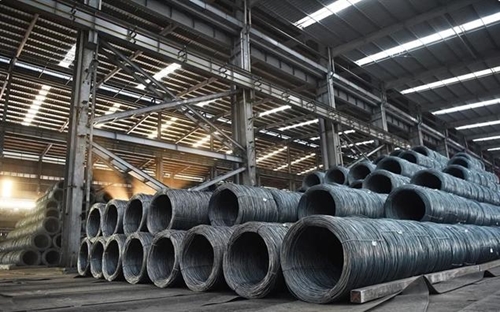Earlier, the Trade Remedies Authority of Vietnam under the Ministry of Industry and Trade (MoIT), said it had received the detailed request for an anti-dumping investigation on hot-rolled steel (HRC) originating from China. The documents have been put under review by the ministry before a decision can be made on whether to proceed with the investigation.
Domestic steel makers said employing the right defense tools can help reduce difficulties and unfair competition and maintain production in the domestic industry.
    |
 |
|
Hot rolled coils in storage at a facility in the Northern province of Ha Nam |
They claimed during the first six months of 2024, more than 5.9 million tons of hot rolled coils (HRC) were imported into Vietnam, an increase of 32% compared to the same period last year and 1.7 times the total local industry's output. Of these, HRC of Chinese origin accounted for nearly 74%, with the average unit prices ranging from 41% - 133% per ton lower than those of other import markets.
Trade defense measures including anti-dumping and anti-subsidy are tools the WTO allows member states to use in protecting their domestic industries. Countries have the right to increase import taxes or apply certain import restrictions without violating WTO commitments or free trade agreements (FTAs) if it is determined that the increase in imports is causing, or threatening to cause, harm to the domestic industry.
Given the unprecedented difficult situation faced by the domestic steel industry, still in recovery after a bad year and the slow property market, the use of trade defense measures can provide domestic steel makers a lifeline, said Dr. Hoang Ngoc Thuan from the Foreign Trade University.
"If we apply trade defense measures at the right time, promptly, proactively and following the law, it will help domestic enterprises reduce competitive pressure from imported goods and avoid threats from unfair competition."
Defense measures have been proven to be effective in the past. In 2017, the Southeast Asian country imposed an anti-dumping tax of 38.34% on galvanized steel products imported from China and the Republic of Korea. After just a year of the tax, imports decreased from 19 million tons (2016) to 15 million tons (2017).
Last month, the ministry said it had started an investigation into the dumping of galvanized steel products from China and the Republic of Korea again after domestic makers reported alleged dumping activities.
Pham Chi Cuong, a former President of the Vietnam Steel Association (VSA) said in 2017, partly thanks to import taxes, the domestic galvanized steel industry developed rapidly, not only meeting domestic demand but also exporting to over 30 markets, including high-standard markets like the U.S. and E.U.
He said failing to implement trade defense measures can result in domestic plants, which are extremely expensive to build, scaling down or shutting down.
As major steel makers in the region including China, India, Japan and the Republic of Korea face excess production, dumping pressure is unlikely to ease soon.
Meanwhile, domestic steel makers have been struggling on the export front, facing increasingly stringent technical and defense measures. By the end of May this year, around 84 trade investigations by foreign authorities had been launched against Vietnamese steel products.
"We encourage the application of trade defense measures for domestic steel products that fully meet domestic demand. For products that do not yet meet demand and still depend on imports, the overall benefits need to be considered to make appropriate decisions," said Nguyen Thi Thu Trang, Director of the WTO and Integration Center from the Vietnam Chamber of Commerce and Industry (VCCI).
In the first six months of 2024, Vietnam imported up to 8.12 million tons of various types of steel, worth 5.9 billion USD, increasing by 46.1% and 24% respectively compared to the same period. Steel product imports were valued at over 3 billion USD, up 23.7%. Total steel and steel product import expenditures reached 8.9 billion USD.
Source: VNA